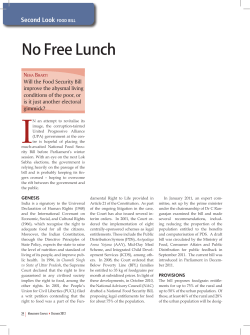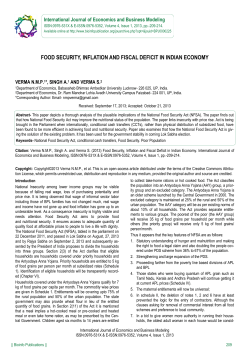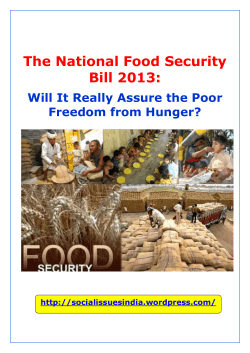
THIS REPORT CONTAINS ASSESSMENTS OF COMMODITY AND TRADE ISSUES MADE... USDA STAFF AND NOT NECESSARILY STATEMENTS OF OFFICIAL U.S. GOVERNMENT
THIS REPORT CONTAINS ASSESSMENTS OF COMMODITY AND TRADE ISSUES MADE BY USDA STAFF AND NOT NECESSARILY STATEMENTS OF OFFICIAL U.S. GOVERNMENT POLICY Voluntary - Public Date: 9/16/2013 GAIN Report Number: IN3105 India Post: New Delhi National Food Security Bill Becomes Law Report Categories: Agriculture in the Economy Grain and Feed Policy and Program Announcements Climate Change/Global Warming/Food Security Approved By: Allan Mustard Prepared By: Allan Mustard Report Highlights: India’s National Food Security Bill was signed into law on September 12, 2013, under which the Government of India is to deliver 5 kilograms of food grains monthly to approximately 820 million eligible beneficiaries. Central government allocations of food grains to the states and union territories are estimated in this act at 54.9 million metric tons per annum, lower than earlier estimates. Pregnant women, lactating mothers, and certain age groups of children are entitled to daily free meals. Executive Summary: India’s National Food Security Bill, 2013, was passed by both houses of Parliament in August and signed into law by President Pranab Mukherjee on September 12. This Act of Parliament creates an entitlement by eligible beneficiaries (50% of the urban and 75% of the rural populations) to receive 5 kilograms of rice, wheat or coarse grain (millet) at subsidized prices of 3, 2 and 1 rupee per kilogram, respectively, for at least the first three years after enactment. This equates to about two thirds of India’s population, or roughly 820 million people. The central government will identify the total number of beneficiaries in each state based on the population census, and the states will be responsible for determining eligibility, and for publishing the names of beneficiaries. In addition, beneficiaries of the Anyodaya Anna Yojana program as well as states with more generous programs are guaranteed continued access to larger entitlements. Pregnant women and lactating mothers are entitled to free meals during pregnancy and for six months post partum, and to a maternity benefit of INR 6,000. Children aged six months to 14 years are entitled to one free meal per day. For purposes of ration card issuance, the eldest woman in the household over the age of 18 is designated head of household. In addition, the Public Distribution System is to be reformed. The government is specifically authorized to introduce cash transfer, food coupon, or other programs in lieu of delivery of physical grain. A system is to be created to permit redress of grievances. Based on published state-by-state allocations, nearly 55 million metric tons of food grains will be distributed annually via the Public Distribution System. General Information The National Food Security Bill, 2011, was introduced into the Lok Sabha (lower house of Parliament) on December 22, 2011, and was referred to the Standing Committee on Food, Consumer Affairs and Public Distribution chaired by Mr. Vilas Muttemwar. The bill languished until Spring 2013 due to tactical moves by the main Parliamentary opposition, the Bharatiya Janata Party, which blocked consideration of it (and much other legislation) until the monsoon session of Parliament in July-August 2013. Nonetheless, during that hiatus government agencies (including the Prime Minister’s Economic Advisory Council, the Reserve Bank of India, and the Ministry of Agriculture’s Commission on Agricultural Costs and Prices) as well as numerous private commentators analyzed the bill, and the Standing Committee held hearings on it. As a result, once consideration of the bill, now called the National Food Security Bill, 2013, resumed, Members of Parliament were prepared to offer over 300 amendments (for an analysis of the unamended draft of this version of the bill, please see GAIN Report IN3037). Most of these amendments, mainly from the opposition, were rejected. Content of the Bill Amendments accepted included the following: “Coverage and entitlement under Targeted Public Distribution System (TPDS): Instead of coverage of up to 75% of the rural population and up to 50% of the urban population under two categories of priority and general households with different entitlements and issue prices provided in the original Bill, there would be only one category of beneficiaries with uniform entitlement of 5 kg per person per month. “Protection of entitlements under Targeted Public Distribution System: The entitlement of Antyodaya Anna Yojana (AAY) households, which constitute poorest of the poor will, however, be protected at 35 kg per household per month. It is also proposed to accept the recommendation of the Committee to protect the existing allocation of food grains to the States/U[nion] T[erritorie]s, subject to it being restricted to average annual offtake during last three years (200910 to 2011-12). “State-wise coverage and identification of beneficiaries: Corresponding to coverage of 75%/50% of the rural/urban population at the all India level, State-wise coverage will be determined by the Planning Commission. The work of identification of eligible households is proposed to be left to the States/UTs, which may frame their own criteria or use the Social Economic and Caste Census (SECC) data. “Subsidized Prices under TDPS and their revision: Uniform prices of Rs. 3/2/1 per kg for rice/wheat/coarse grains will be applicable to all eligible beneficiaries. It is proposed to fix these prices for the first three years of implementation of the Act, and thereafter link the same suitably to MSP. “Cost of intra-State transportation & handling of foodgrains and FPS Dealers’ margin: In order to address the concerns of States/UTs regarding additional financial burden, it is proposed that Central Government may provide assistance to States towards cost of intra-State transportation, handling of foodgrains and FPS Dealers’ margin, for which norms will be devised. “Maternity benefit: It is proposed to allow States/UTs to use the existing machinery of District Grievance Redressal Officer (DGRO), State Food Commission, if they so desire, to save expenditure on establishment of new set up.” The Bill was passed by the Lok Sabha (lower house) after nine hours of debate. This version of the Bill included the following widely publicized highlights: Two thirds of India’s population to get highly subsidized food grains: Up to 75% of the rural population and up to 50% of the urban population to be entitled to 5 kg of food grains per month at the highly subsidized prices of INR 3, INR 2, INR 1 per kg for rice, wheat, coarse grains, respectively, to be delivered via the Targeted Public Distribution System; Poorest of the poor to continue to get 35 kg per household: The poorest of poor households would continue to receive 35 kg foodgrains per household per month under Antyodaya Anna Yojana at subsidized prices of Rs 3, Rs 2 and Rs 1. Existing allocation of foodgrains to the states/union territories, where they are already larger, are preserved, subject to a restriction to average annual offtake during the last three years; Eligible households to be identified by the states: Beneficiaries to consist of 75% of the rural and 50% of the urban population at the all-India level, with state-wise coverage to be determined by the Planning Commission. Identification of eligible households is left to the states/union territories, which may frame their own criteria or use Social Economic and Caste Census data. Special focus on nutritional support to women and children: Pregnant women and lactating mothers, besides being entitled to nutritious meals as per prescribed nutritional norms, will also receive a monetary maternity benefit at least of INR 6,000. Children aged 6 months to 14 years are to be entitled to either a “take home ration” or hot cooked food (i.e., hot school lunch) as per prescribed nutritional norms. Food Security Allowance in case of non supply of food grains: the central government will provide funds to states/union territories in case of short supply of food grains from the central pool. In case of non-supply of food grains or meals to entitled persons, the concerned state/union territory governments will be required to provide such food security allowance as may be prescribed by the central government to the beneficiaries. States to get assistance for intrastate transportation and handling of food grains: In order to address the concern of the states regarding additional financial burdens, the central government will provide assistance to the states towards the cost of intra-state transportation, handling of food grains and Fair Price Shop dealers’ margins. Reforms for doorstep delivery of foodgrains: Reforms are mandated for doorstep delivery of food rains, application of information and communication technology, including end to end computerization, leveraging the universal identification (“aadhaar”) for unique identification of beneficiaries, and diversification of commodities under the Public Distribution System. Women’s Empowerment: The eldest woman of eighteen years of age or above will be head of the household for issue of ration card, and if not available, the eldest male member is to be the head of the household until such time as the eldest woman attains the age of 18 years. Grievance redress mechanism at district level: There will be state and district level redress mechanism with designated officers. The redress mechanism may also include call centers and help lines. Social audits and vigilance committees: The Bill mandates public disclosure of records relating to the Public Distribution System, including publication of lists of beneficiaries, social audits and setting up of Vigilance Committees in order to ensure transparency and accountability. Four other significant but less publicized amendments to the original 2011 Bill were also adopted: Section 3: If the amount of food grains stipulated in Schedule IV appended to this Act is less that the annual average of the last three years’ offtake by a given state’s Public Distribution System, additional grain to top up to that average shall be delivered, but “at prices as may be determined by the Central Government…” (this modifies earlier language, under which the states would have been able to procure additional grains from the central government at the highly subsidized prices of 3, 2 and 1 rupee per kilogram); Section 39 (1): Promulgation of implementing rules by the central government shall be carried out “in consultation with the State Governments” (this was a specific request of the states of Bihar and Rajasthan); Section 39 (2) (d): “…schemes of cash transfer, food coupons or other schemes to the targeted beneficiaries” are specifically authorized (pilot programs are envisioned); and Language in the 2011 version of the Bill mandating that after three years the subsidized prices of rice, wheat, and coarse grains would be “suitably” linked to the minimum support price was stricken, and replaced by Schedule I (this drops the ambiguous term “suitably” and merely caps any future subsidized retail price at the MSP). The Act as published on September 10 by the Ministry of Law and Justice includes four appended schedules: Schedule I establishes the prices for rice, wheat and coarse grains (generally understood to mean millet) of INR 3, 2, and 1, respectively, but notes, “…for a period of three years from the date of commencement of this Act; and thereafter, at such price, as may be fixed by the Central Government, from time to time, not exceeding, -i. ii. the minimum support price for wheat and coarse grains; and the derived minimum support price for rice, as the case may be.” Schedule II contains nutritional standards for children, pregnant women and lactating mothers, and mandates that they shall be given either a “take home ration” or a meal in accordance with these standards: Category Children (6 months to 3 years) Children (3 to 6 years) Children (6 months to 6 years) who are malnourished Lower primary classes Upper primary classes Pregnant women and Lactating mothers Type of meal Take Home Ration Morning Snack and Hot Cooked Meal Take Home Ration Hot Cooked Meal Hot Cooked Meal Take Home Ration Calories (Kcal) 500 500 Protein (g) 12-15 12-15 800 20-25 450 700 600 12 20 18-20 Schedule III contains “Provisions for advancing food security”: “(1) Revitalisation of Agriculture— (a) agrarian reforms through measures for securing interests of small and marginal farmers; (b) increase in investments in agriculture, including research and development, extension services, micro and minor irrigation and power to increase productivity and production; (c) ensuring livelihood security to farmers by way of remunerative prices, access to inputs, credit, irrigation, power, crop insurance, etc.; (d) prohibiting unwarranted diversion of land and water from food production. “(2) Procurement, Storage and Movement related interventions— (a) incentivizing decentralized procurement including procurement of coarse grains; (b) geographical diversification of procurement operations; (c) augmentation of adequate decentralized modern and scientific storage; (d) giving top priority to movement of foodgrains and providing sufficient number of rakes for this purpose, including expanding the line capacity of railways to facilitate foodgrain movement from surplus to consuming regions. “(3) Others: Access to— (a) safe and adequate drinking water and sanitation; (b) health care; (c) nutritional, health and education support to adolescent girls; (d) adequate pensions for senior citizens, persons with disability and single women.” Schedule IV provides the state-by-state allocation of food grains, with a total of 54.926 million metric tons. From the Lok Sabha the Bill was sent to the Rajya Sabha (upper house), where it passed on August 27. It was then sent to President Mukherjee for his signature, which was done September 12. Scope of the Program In its January 2013 report, the Standing Committee estimated the food grains requirement at 61.55 million metric tons (mmt) in Indian fiscal year 2012-13. As of May 2013, the Ministry of Consumer Affairs, Food and Public Distribution estimated the annual food grains requirement at 61.23 mmt and a corresponding food subsidy price tag at IFY 2013-14 costs of about INR 1.25 trillion. In May 2013, the Ministry of Agriculture’s Commission on Agricultural Costs and Prices (CACP) calculated the grain requirement as follows: Table 1: Requirements under NFSB, 2011, (Million Tons) Requirement for Beneficiary Population (67% of 1.215 billion @ 5 kg per person) Addl. Requirement for AAY1 (@2 kg for 2.5 crore2 households of 5 persons per household)# Estimated Requirement for OWS3 Additional requirement for protecting the average annual off‐take of States* Wheat 22.0 Rice 26.8 Total 48.8 1.4 1.6 3.0 2.9 1.3 3.6 1.6 6.5 2.9 Total Annual Requirement 27.6 33.6 61.2 Monthly Requirement (Annual Requirement/12) 2.3 2.8 5.1 Note: 1. Rice to Wheat ratio for the total foodgrain requirement has been assumed to be 55:45 on the basis of the ratio in total procurement during 2007‐08 to 2011‐12 which was 54.5% (Rice) & 45.5% (wheat) 2. The population of India according to the census 2011 is 1.215 billion # Beneficiaries under AAY are entitled to 7 kg per person * Average annual off‐take of three years (2009‐10 to 2011‐12) Source: Gulati, Ashok, and Surbhi Jain, Buffer Stocking Policy in the wake of NFSB: Concepts, Empirics, and Policy Implications, Commission on Agricultural Costs and Prices, May 2013, page 11. 1 AAY – Antyodaya Anna Yojana (poorest of the poor) program 2 A crore is ten million. 3 OWS – Other Welfare Schemes, i.e., other feeding programs The Bill as passed, as noted above, establishes a state-by-state allocation that totals just under 55 million metric tons; this figure appears to omit “other welfare schemes” included in the CACP’s calculations. These estimates are significantly lower than the 76 mmt projected under terms of the first draft of the Bill in 2011. Economic Impact The fiscal, economic and monetary impacts of the National Food Security Act continue to be hotly debated. In its January 2013 report, the Standing Committee calculated, “As per the provisions of the National Food Security Bill (NFSB) the food subsidy for 2011-12 would have been Rs. 98,842 crores (INR 988.42 billion) and will increase during 2012-13 to Rs. 1,12,205 crores (INR 1.12205 trillion). In this computation of food subsidy, the household size does not matter because the entitlement as per the NFSB is on individual basis and not based on family size. The percentage of population to be covered is also indicated in the NFSB and is independent of any poverty estimates to be indicated by the Planning Commission. “As is clear from the aforesaid, there will be a marginal increase in the overall food subsidy bill because of the operationalization of the provisions of NFSB. “The additionality during 2012-13 works out to be…Rs.2409 crores (INR 24.09 billion).” The CACP, however, calculated higher figures in a comprehensive December 2012 analysis, estimating that in the first full year of implementation, all costs attributable to program operation, management and oversight, not merely grain procurement and sale, would total over INR 2.4 trillion, with that number falling in years 2 and 3 to 2.2 and 2.17 trillion rupees, primarily due to declining need for introduction of agricultural production enhancements. Commodity acquisition costs, however, were projected to rise. In addition, some observers have cautioned that the Bill will have an inflationary impact more generally. The minutes of the Reserve Bank of India’s Technical Advisory Committee meeting of July 24, 2013, noted, “Food prices are still elevated and the food security bill will aggravate food price inflation as it will tilt supply towards cereals and away from other farm produce (proteins), which will raise food prices further.” The RBI additionally stated in its May 2013 quarterly report, Persistent increases in domestic food prices during 2012-13, despite range-bound global food prices, calls for a relook at the overall agriculture price policy, where [minimum support prices] and large buffer stocks are the two major policy tools. While food security is of paramount importance in a country such as India, recent experience suggests that large buffer stocks have not been effective in dampening prices, even as the system is bearing large carrying costs and storage losses. Also, significant increases in the cost of production in agriculture, driven largely by the increase in wage costs, added to pressure on food prices. As has been highlighted in the past, the changing pattern of consumption in favour of protein-rich items has not been matched by supply elasticities, which added pressure from the demand side. Addressing these issues by augmenting supply capacities could be critical in achieving the goal of stable food prices. This is an oblique reference to the impact of abnormally high government procurement on availability of wheat in the open market for private flour milling, which in 2012 led to high domestic wheat prices and short supplies despite India’s excellent wheat harvest. Despite availability of high government wheat stocks, the private market was short (see GAIN Report IN2112). The RBI warned in the following quarter’s report, “Although the existing stocks of foodgrain are sufficient, the requirements may have to be re-assessed in light of the expected higher off-take under the National Food Security Bill (NFSB), when implemented.” The CACP was more direct in its assessment, identifying the following four specific issues: Impact on investment: The Bill “…is likely to shift the nature of resource allocation more towards subsidies rather than investments. This will be retrogressive from long term agri-growth and sustainable food security point of view.” Focus on rice and wheat at the expense of higher-value agriculture: “The Bill's focus on rice and wheat goes against the trend for many Indians who are gradually diversifying their diet to protein-rich foods such as dairy, eggs and poultry, as well as fruit and vegetables. There is a need for a more nuanced food security strategy which is not obsessed with macro-level foodgrain availability. But at the policy level, the Government is still focused on foodgrains and with NFSB is clearly reversing the movement of Indian agriculture from high value items to foodgrains. This will trap the Indian agricultural sector in a low level equilibrium trap as returns are generally higher in high value agriculture. But a faster movement towards high value agriculture needs large investments in infrastructure and risk mitigating strategies. The NFSB is likely to slow down this natural process, and at places even reverse this trend.” Disincentive to private-sector involvement in food grain trade: “In pursuit of the food sufficiency regime a regulatory framework has been created with massive government intervention in terms of policing powers under the APMC Act and Essential Commodities Act, interstate movement restrictions, regular but unpredictable export bans on foodgrains, banning of forwards trading on commodity exchanges etc. This will be even further tightened to enable government to carry out its procurement functions now. A combination of the quantum of public procurement and a stringent regulatory framework would drive the private sector out of the food grains sector. “Since 2006-07, the procurement levels for rice and wheat have increased manifold with more than one-third of the total production being procured for Central Pool...This will be even more pronounced if procurement is taken as a share of marketed surplus -more than 40 percent for rice and more than 50 percent for wheat. Currently, piling stocks of wheat with FCI has led to an artificial shortage of wheat in the market in the face of a bumper crop. Wheat prices have gone up in domestic markets by almost 20 percent in the last three months alone, because of these huge stocks with the government that has left very little surplus in markets. Apart from imposing a huge additional cost to procure, store, transport and distribute grain, increasing public procurement strangulates the domestic grain market.” Food price inflation pressures: “India has recently been experiencing high food inflation in the face of record production of food grains, robust buffer stocks and growing resilience of agriculture to monsoon uncertainties. A distinct feature of recent food price inflation has been the sustained price pressure in protein rich items (pulses, milk, fish, meat and eggs). According to RBI, the inflationary impact of NFSB will depend on the extent to which it will raise demand for food grains relative to the normal increase in supply. This will create demand pressures, which will inevitably spillover to market prices of food grains. Furthermore, the higher food subsidy burden on the budget will raise the fiscal deficit, exacerbating macro level inflationary pressures. Additionally, the need to procure large amounts would need a consistent rise in MSP of the foodgrains to incentivize their production further fuelling the inflationary pressures. This will create further macroeconomic imbalances. “NFSB focus on cereals is likely to induce severe imbalance in the production of oilseeds and pulses, resulting in substantial imports in the coming years…Assured procurement gives an incentive for farmers to produce cereals rather than diversify the production-basket. Import intensity will intensify at higher prices creating inflationary pressures. Vegetable production too may be affected - pushing food inflation further.” During hearings on the Bill, the Department of Food and Public Distribution warned that within a few years the Bill’s food grain requirements might exceed the nation’s procurement capacity: “The Department of Food and Public Distribution stated in this regard that this means that the foodgrains requirement will increase with increase in population and increase in production and procurement of foodgrains will have to keep pace with such increases in foodgrain requirement. The Table below gives the estimated requirement of foodgrains based on provisions of the Bill, using the projected population of that year along with the projections of production and procurement of wheat and rice made by the Ministry of Agriculture: Year Projection of Production, Procurement and Requirement of Foodgrains (in million tons) Production Procurement Foodgrains requirement (Wheat & Rice) (Wheat & Rice) under TPDS and OWS (As projected by Adjusted Min. of Agri.) 73.182 2011198.22 60.74 121 2015196.32 64.18 67.18 64.46 16 2020207.48 67.83 70.83 69.67 21 2025219.29 71.68 74.68 75.39 26 1 Production as per 4th Advance Estimate and actual Procurement as on 10.10.12 2 Actual as on 10.12.2012 [December 10, 2012] Source: Standing Committee on Food, Consumer Affairs And Public Distribution (2012-13), Fifteenth Lok Sabha, Ministry Of Consumer Affairs, Food And Public Distribution (Department Of Food And Public Distribution), The National Food Security Bill, 2011, Twenty Seventh Report, January 2013, pages 85-86 “As can be seen, the estimated requirement of foodgrains is likely to surpass the projected procurement in 2015-16. It may however be noted that the projection of wheat production for 2011-12 was about 10 million tons below the actual production and therefore even the future projections could be on the lower side. Accounting for this and assuming that 1/3rd of the production will be procured, the projection of the Ministry of Agriculture regarding procurement can be suitably adjusted upwards by 3 million tons. Even then, shortfall in foodgrain availability in the Central Pool is anticipated in 2025-26. It may however be noted that projections of procurement done by the Ministry of Agriculture is [sic] based on the assumption that about one third of the total production of wheat and rice will be procured. It would be difficult to sustain procurement at this level year after year…”
© Copyright 2025





















